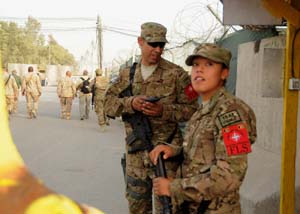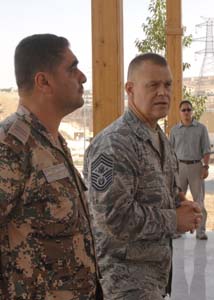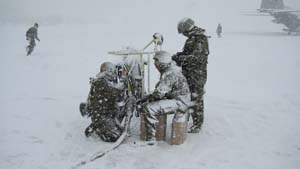The Air Force has postponed implementing its new air and space expeditionary force (AEF) model at least a year, but leaders are confident that once in place, AEF Next will provide the predictability and stability promised when the concept was first introduced more than a decade ago.
Ten years of fighting two wars forced the Air Force to move away from unit-based deployments, which was the original mandate for air expeditionary forces. In its place, a piecemeal approach evolved. Smaller and smaller elements—sometimes even a lone airman from a specific squadron—deployed to an overseas location, creating, it is hoped, “serendipitous” unit cohesion, Gen. Norton A. Schwartz, then-Air Force Chief of Staff, said in June.

| ||
|
SrA. Chad Mann (l) and A1C Crystal Martinez, security personnel at Kandahar Airfield, Afghanistan, prepare to respond to a situation on the flight line. Mann was on his third deployment to the region, Martinez her first. (USAF photo by SSgt. Heather Skinkle) |
Still, “my sense is that we need to recycle a bit back toward the more unit-based deployments that we had before the surge period in Iraq and Afghanistan, where commanders and chiefs and first sergeants actually deploy with their people and fight with them,” he said. “So instead of, let’s say, 35 wings in our Air Force contributing to the expeditionary wing at Bagram, maybe it will only be five wings. And those five wings will actually train and associate together.”
Deploying Alone
The ultimate goal for AEF Next is to build a more cohesive deployment cycle that allows for surge without requiring a complete restructuring of the existing cycle. The built-in predictability of such a model would allow airmen to know exactly when they will deploy, how long they’ll be gone, and when they’ll return. In addition, for the first time, the Air Force should be able to synchronize its deployment schedule with permanent change of station moves, continuing education, and other personnel activities, promoting a better work-life balance for airmen while boosting the overall readiness of the force.
According to CMSAF James A. Roy, instead of today’s complicated “tempo banding” system—which few airmen claim to actually understand—the new deployment system will be made up of six different airpower teams, all based on Air Force core functions and values: strike; mobility; command and control intelligence, surveillance, and reconnaissance; space and cyberspace; special operations; and agile combat support.
Each of the six major categories will be broken into subcategories defined by mission type. Though the exact breakdown is still in draft form, the idea is to bundle like capabilities together. For example, a larger strike group could include a smaller air superiority airpower team that may combine pilots and maintainers from squadrons at JB Langley-Eustis, Va.; Seymour Johnson AFB, N.C.; and Shaw AFB, S.C., all of whom have matching mission sets, said Col. John Long, chief of the Air Force war planning and policy division at the Pentagon.
Those teams would then train together at home base or in exercises such as Red Flag and deploy together downrange, creating a more unified battle rhythm.
“One of the complaints I hear all the time,” Roy said last September, is, ” ‘Why am I deploying by myself? I’m falling in on another team that fell in on another team, and it’s just kind of a mismatch.’ … [AEF Next] will help clarify that.”

| ||
|
CMSAF James Roy (r) and Mowafaq Mohammad Al-Mastafa, Chief Master Sergeant of the Royal Jordanian Air Force, speak to US airmen and coalition personnel during Exercise Eager Lion in Jordan this May. Roy says six types of airpower teams will make up the new deployment system. (USAF photo by 1st Lt. Nicholas Mercurio) |
Speaking at AFA’s Air and Space Conference outside Washington, D.C., Roy added, “I like it because what it does is you fight like you train. You certainly train like you fight, but the idea is you fall in with your unit leadership. You deploy as a unit rather than as an individual. It’s a little bit different than what we do today.”
The air expeditionary force concept originated in the mid-1990s during the Balkan conflict. At the time, the commander of USAF forces in Bosnia didn’t have a clear line chain of command for units that reported to him directly. Gen. Michael E. Ryan, who served as the commander of US Air Forces in Europe from 1996 to1997 and was later Chief of Staff, wanted to see a single airman in charge of all USAF forces committed to the fight.
Eventually, the AEF concept evolved in an attempt to address the larger issue of predictability for airmen, said Bradley Higginbotham, chief of the plans division in the AEF directorate at Air Force Personnel Center.
When the concept was initially implemented a few years later, there were 10 AEFs, or equivalent composite groupings of capabilities, such as fighters, bombers, and support, all under a single wing commander. The Air Force then paired those 10 AEFs together for a total of five pairs that deployed nose-to-tail in 90-day increments.
When the Afghanistan war broke out, the assumption was that the Air Force’s superior airpower would allow the service to go in, kill the enemy, and then come home as the Army and Marines took over the mission on the ground, said Higginbotham. That’s not exactly how things worked out. The original AEF deployment structure soon became unsustainable, and the Air Force was forced to continually tinker with the construct in an attempt to get it right. In 2004, the standard 90-day deployment was extended to 120 days, and in 2010 it was changed again, to half a year, with varying lengths of time between deployments.
“What we mis-predicted was that we would be allowed to come back to a sustainment level that allowed us to come back to 90-day deployments without having to surge or take extra people,” said Higginbotham.
To adapt, the Air Force converted to the tempo banding system used today. It includes five bands for Active Duty—at different deploy-to-dwell ratios—and two completely separate bands for the reserve components.
The “A band” is the baseline for peacetime operations. Active Duty airmen assigned to this band deploy for 120 days at a deploy-to-dwell rate of one-to-four. Only about 10 percent of the force remains in this band today.
Blending the Reserves
Airmen in “B band” deploy for six months instead of 120 days but still operate at a one-to-four deploy-to-dwell. The vast majority of the force, however, has been bumped to bands C to E to accommodate the last decade’s high operational tempo.
“C band” reduces the dwell to 18 months, so airmen under this band operate at a one-to-three deploy-to-dwell even though they still deploy for six months at a time. Those in “D band” operate at one-to-two and are typically deployed for six months and are home for 12 months.
The most stressed career fields, such as explosive ordnance disposal, fall into the “E band” and operate at one-to-one, or six months out and six months at home.

| ||
|
Airmen and marines work at a refueling point at an airport in Japan during a March 2011 disaster relief mission. AEF Next should increase readiness by 10 to 15 percent, by synchronizing deployment, assignment, and force development schedules. (USAF photo) |
The banding concept was created based on combatant commanders’ requirements and is now driven largely by enemy actions. Although the more stressed bands were never meant to be permanent, necessity has forced them to become so. The Air Force reviews the system every year, but once an Air Force Specialty Code gets bumped up a band, Higginbotham said, he can’t remember a time when it has ever gone back down.
“Part of that is driven by force structure cuts, some of it is driven by the other services,” he observed.
Another problem with today’s system is that despite efforts to integrate the Active Duty and reserve components, the Air National Guard and Air Force Reserve operate on two completely separate bands from the Active Duty. The “M band” is at a mobilization-to-dwell ratio of one-to-five, while the “N band” is at a mobilization-to-dwell ratio of one-to-four. Mobilization-to-dwell, as opposed to deploy-to-dwell for Active Duty, allows for more ramp up time before deployment for Guardsmen and Reservists.
“They do not [align] with their Active Duty units. It’s not predictable so we can take a blended unit or a … composite unit and get them to volunteer or mobilize and go together,” said Higginbotham. “Frankly, that was part of our disconnect. We have blended the Guard and Reserve together, and now, the last count I saw is 117 units, but we don’t have a good planning standard for when we can have access to the Guard and Reserve, nor do we have a good standard for what they have to be able to contribute to the fight either in a volunteer status or through mobilization status.”
What AEF Next is intended to do is simplify today’s complex deployment system and give senior leaders more visibility into stressed career fields by putting all AFSCs back on the same battle rhythm. In theory, all Active Duty airmen will operate at a one-to-two deploy-to-dwell and the reserve components will operate at a one-to-five mobilization-to-dwell.
Higginbotham said the Air Force “almost had it right” with the original AEF construct, but instead of the five pairs it really needed six. That would allow for a deploy-to-dwell of one-to-two, with one unit deployed, one unit just coming back, and another one getting ready to go out, he said.
“If I want to surge, I have to have a multiple of three and that’s what AEF Next does. It goes in six AEFs, not five,” he said. “When I do that, I can send out a part of a unit and instead of going nose-to-tail, I overlap them. I have a six-month deploy-to-dwell for the people in AEF I, but six months into that, I have another group of AEF units that overlap by three months. If I send out two of the six AEFs, I have one-third of the Air Force deployed.”
The added benefit, said Higginbotham, is that the new model allows the Air Force to send the Guard and Reserve out for three-month increments, instead of six months, allowing them to match up with their Active Duty counterparts.
“If I do that for three months over an 18-month period, you can see they are out for three months, come back for 15 months, then I’m at a [mobilization] -to-dwell of one-to-five. It’s magic how the numbers match up mathematically,” he said. “Now I can predictably assign my Guard and Reserve units with their Active Duty units that they are going to go and support on their time line of one-to-five while I’m executing the Active Duty at one-to-two.”
The three-month gap between when the first and second units deploy also means there is never a break in the home station mission.
Schwartz signed off on the new model in November 2011. However, during June’s Corona summit—a periodic powwow of top Air Force generals and civilians—the leadership decided to delay AEF Next’s initial operational capability from October 2012 to 2013. That means AEF Next is not expected to be fully implemented until 2015—a full year after the US plans to withdraw the vast majority of its troops from Afghanistan.
Officials most familiar with the plan say it would be too difficult to change the deployment cycle during wartime because of the way today’s banding system is set up. What USAF is trying to avoid is the need to assign an airman who recently returned from Afghanistan to an airpower team that’s on the hook to deploy again. It would mean airmen would not get any dwell time back home.
In order for AEF Next to really work, everyone in an airpower team needs to be on the same schedule and everyone must be able to deploy together as one team.
To transition during wartime, ” I would have to institute a series of waivers to move everybody and it would take about 12 to 18 months to transition. And then I would do it on the backs of my airmen in an unpredictable fashion and that’s not something the Air Force is willing to do,” said Higginbotham. “We’ve spent a lot of time trying to figure out how to do this better and not injure airmen or their personal lives or their predictability while we do it.”
Showing the Assets
During the 40-minute Corona briefing on AEF Next, senior leaders decided the concept needed more analysis to ensure the Air Force gets it right this time. Long said he expects to report back to leadership with that analysis by year’s end.
Although the airpower teams have mostly been worked out on paper, some have yet to be vetted. Agile combat support continues to be one of the biggest sticking points because it is “one area that’s very, very vast,” said Roy.
ACS is based on a force module that says airmen assigned to that airpower team must be able to open and establish a base, sustain the fight, and protect the force. That’s a diverse mandate encompassing a variety of AFSCs, such as civil engineering, EOD, aeromedical evacuation, and even more specialized career fields such as RED HORSE combat construction, said Long.
The challenge is “trying to capitalize on the diversity of those groups in today’s environment where the Air Force offers tremendous capability, even down to single-person [unit type codes] to a deployed location,” added Long. “It has worked over the last 10 years, but we believe that there may be some room for improvement.”
Unit type codes are updated and monitored in a live database known as the Joint Operation Planning and Execution System. JOPES is a complex system that requires all the services operating within it to have a standard of measure, said Higginbotham.
So, for example, through JOPES, a commander can take a fighter squadron with 12 aircraft and see right away what equipment must deploy with it. The system allows him to follow the logistical movement, but also to see how many of those aircraft are operationally capable and report that information back to the Secretary of Defense.
Because the Air Force is moving out of the banding system, all of those UTCs will have to be reworked.
Air Force officials are still in the process of dividing UTCs and mission capability structures for each of the airpower teams. Once all that is worked out, the service will be able to report to the Defense Secretary exactly how many airmen are deployed throughout the world, how many airpower teams are committed to the war, and how many are supporting the fight from their home stations.
“We can show all of the assets. What’s been used, what’s coming back to be reset, and what’s going out the door,” said Higginbotham. “This is all tied to a SecDef initiative for global force management called ‘adaptive planning.’ That is to be able to tell the SecDef very quickly, usually within 30 days, all his assets he has committed, [so] if [he] wants to do something different, he can.”
Finally, AEF Next should increase readiness by 10 to 15 percent just by synchronizing deployment time lines with the assignment and force development time lines, said Higginbotham.
“The reason is because everyone is at a different deploy-to-dwell and for the last six years we have been rebanding to more and more stressed tempo bands, [so we haven’t been able to] synchronize an assignment action, which is typically decided a year in advance, [with] a deployment action, which is typically decided between four to six months in advance,” he said.
In other words, airmen who should have been prepared for deployment were not available to fight because of the lack of continuity between personnel actions and deployment schedules, added Higginbotham.
“This is not rocket science. This can be done. And that’s the end piece of AEF Next, which I think will be a benefit to all of our people,” said Schwartz.